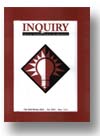|
1.
|
Inquiry: Critical Thinking Across the Disciplines:
Volume >
21 >
Issue: 1
Robert L. Williams, Stephen L. Worth
The Relationship of Critical Thinking to Success in College
abstract |
view |
rights & permissions
| cited by
The definition, assessment, predictive validity, demographic correlates, and promotion of critical thinking at the college level are addressed in this article. Although the definitions of critical thinking vary substantially, a common theme is the linkage of conclusions to relevant evidence. Assessment measures range from quasi-standardized instruments to informal class assessment and include both generic and subject-specific formats. Although critical thinking potentially serves both as a predictor of college success and as a criterion of suceess, its greater utility may be as a predictor. nonetheless, the college experience in general and critical thinking courses in particular offer some promise for promoting critical thinking. However, efforts to infuse critical thinking activities into subject-specific courses have produced marginal improvement in critical thinking.
|
|
|
2.
|
Inquiry: Critical Thinking Across the Disciplines:
Volume >
21 >
Issue: 1
Andrés Mejía D.
Reconstruction in Criticality:
A Discussion on Questions, Assumptions, and Interpretation
abstract |
view |
rights & permissions
| cited by
Some authors have argued that consideration of alternative claims, theories, or worldviews is necessary for a proper or sound critical assessment of a claim or set of claims. However, an understanding of interpretation and beliefs as inherently holistic suggests that interpretation already involves the recogllition of alternatives, and that therefore assessment also necessarily involves their comparison. Starting from this idea, it will be argued that presuppositions can be regarded as limits to the range of alternatives that are considered by the author of the claims, as seen by an interpreter making the assessment. However, a result of this consists in the fact that these assumptions can only be found in the conversational interaction between the author’s and the interpreter’s broader belief systems. Some implications for a conversational form of criticality will also be derived from here.
|
|





